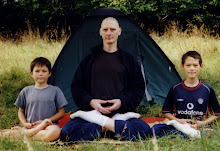What "mental sitting" is I do not know. But Marjory Barlow, Nelly Ben-Or and one or two other teachers of the FM Alexander Technique have given me some clues as to what it is not.
It is not a muscular effort of doing; it is not anchored in feeling; it is not postural self-arrangement or self-organization; it is not reliance on habit; it is not any kind of bodywork; it is not mindless mechanical repetition; and it is not thinking as I have hitherto understood thinking.
Although the kind of mental work that Alexander practised is not thinking as thinking is generally understood, FM Alexander called it "thinking."
To what extent might this kind of thinking be relevant to a buddha's practice of upright sitting? Is it possible to interpret HISHIRYO, or "anti-thinking," not only as physical action that is opposed to thinking, but also, from the dialectically opposite viewpoint, as mental thinking that is opposed to the habitual doing (stemming from faulty feeling, misconceptions, et cetera) that ordinarily governs the body ?
Is it possible to understand HISHIRYO like this, both as an affirmation of action that negates thinking and at the same time as an affirmation of thinking that negates doing?
According to what I was taught by Gudo Nishijima, No! Never! According to Gudo, HISHIRYO must never be interpreted as anything other than a negation of thinking. HISHIRYO means not thinking but action, not thinking but just doing. That was Gudo's strongly-held view.
Master Dogen's instructions for sitting-zen, however, include the sentence that "It is vital to bring about an opposition between the ears and the shoulders, and an opposition between the nose and the navel." (MIMI TO KATA TO TAISHI, HANA TO HESO TO TAISESHIMEN KOTO O YOSU).
How is it possible to bring about such an opposition? Is it possible, by direct muscular intervention, by doing something, to bring about a movement ears and shoulders away from each other? No, it is not. What muscular effort can do is pull the shoulders and ears towards each other. For direct muscular intervention to succeed in pulling ears and shoulders apart, there would need to be muscular attachments joining ears to the ceiling and joining shoulders to the walls on either side. Bringing about an opposition between ears and shoulders requires not direct muscular effort but rather muscular release, not doing but rather undoing.
My Alexander head of training, Ray Evans, used to say that we know more about the mechanisms of muscular effort (i.e. "doing") whereas the mechanisms of release (or "undoing") are less well understood.
Marjory Barlow used to emphasize, "You cannot do an undoing." When I started working with Marjory, she caused me to understand that, despite 15 years of sitting-zen practice under Gudo Nishijima, and two years of Alexander teacher training, I was still wrongly of the view that I might be able to do an undoing. So Marjory often reminded me, "You cannot do an undoing."
A further 11 years of Alexander work since my first lesson with Marjory have still not equipped me with a definitive view of what "mental sitting" is, but I have been caused to be able to see, on a good day, what it is not.
It is not muscular effort. It is not what I know. It is not my misguided effort to arrange myself symmetrically. Above all, it is not doing. On the contrary, it is diametrically opposed to doing, just as doing is diametrically opposed to thinking.
Have I thus just expressed a view on what "mental sitting" is? If so, I did so, not for the first time, in error. Whenever I decide upon a view on what "mental sitting" is, which I frequently do, it always turns out to be... not that.
I do not know what Master Dogen meant by "mental sitting." What I do know is that the prejudice I used to hold against what I perceived as sissy mental practice, was just the stupid prejudice of an unenlightened person.
The question I have addressed above is not how to become buddha, and not how to cultivate the empty field. The question here is not even how to take the backward step of turning light and shining. The question is just how to practise mental sitting. That is the question Master Dogen posed 750 years ago.
Understanding that the work of FM Alexander poses the same question, I came back to England to train as an Alexander teacher. And so, as my day job in England, I teach people who are sitting to think up from their sitting bones. But that does not mean that I know what thinking up is, any more than a plumber knows what water is.
Inevitably, I have my views and opinions about what FM Alexander meant by "thinking," and about what Master Dogen meant by "mental full lotus sitting," but those views and opinions always turn out to be mistaken.
Still, since I came to France with the intention of making mistakes, let me conclude this post by deliberately making a big one:
To practise mental full lotus sitting means, for example, to think the ears and shoulders apart, and to think the head out from the pelvis. Not to do it; just to think it.
Sunday, 30 March 2008
Subscribe to:
Post Comments (Atom)

No comments:
Post a Comment